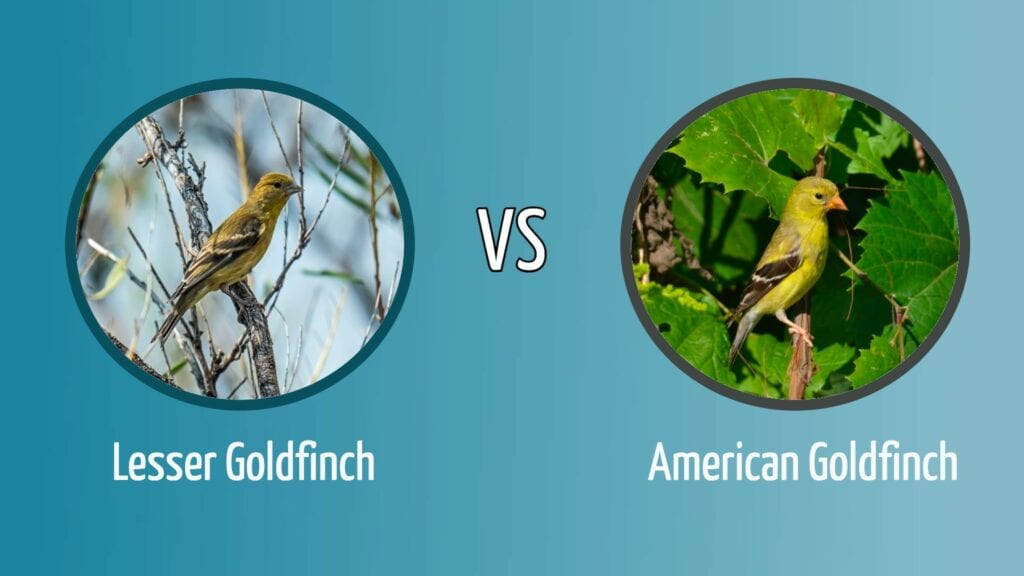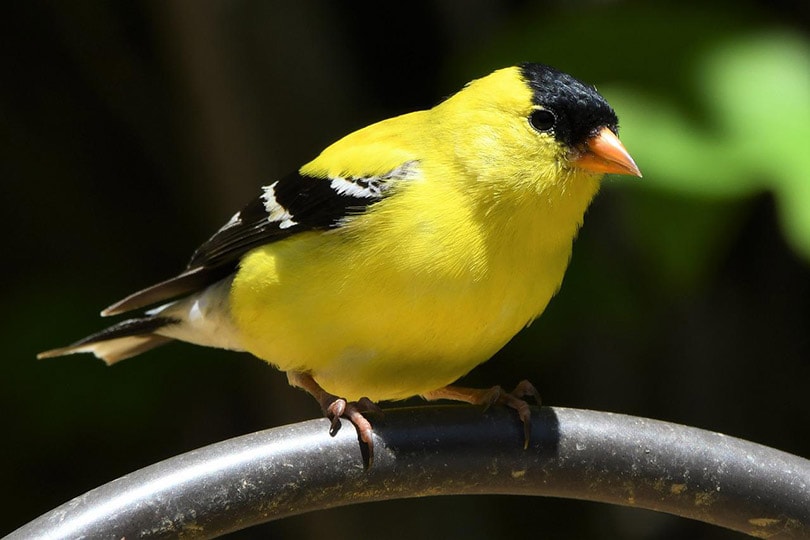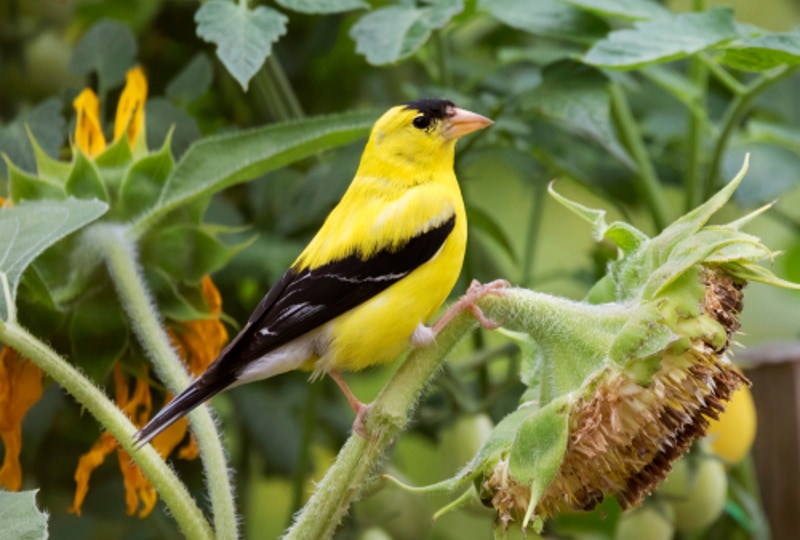Lesser Goldfinch vs. American Goldfinch: How to Tell the Difference
Last Updated on

If you’re a birdwatcher or put out a feeder, the chances are you’re familiar with these two species. The American Goldfinch is more widespread than the other bird. Nevertheless, both share many characteristics and behaviors of other songbirds. They are year-round residents in at least part of their respective ranges. Both live in a wide spectrum of habitat types, making them quite adaptable.
The Lesser Goldfinch and American Goldfinch are part of the finch or Fringillidae family of birds. They belong to the same genus, Spinus. They are two out of the three species of this group in the United States. The third, the Lawrence’s Goldfinch, is more nomadic than the others. While much is known about them, less is understood about the latter.

Visual Differences

At a Glance
- Scientific Name: Spinus psaltria
- Range: Western United States into Mexico
- Size: 3–5 inches, 0.3 ounces
- Lifespan: 7 years; 7 years (USGS banding data)
- Conservation Status (Population): Species of Least Concern (11 million)
- Scientific Name: Spinus tristis
- Range: At least a part-time resident in the lower 48 states into Canada
- Size: 5–9 inches, 0.5 ounces
- Lifespan: 13 years; 9.8 years (USGS banding data)
- Conservation Status (Population): Species of Least Concern (44 million)

Lesser Goldfinch Overview

The Lesser Goldfinch lives in a wide range of habitat types in the Western United States. You’ll find it in shrublands, agricultural fields, and open woods. It is a nomadic species and, thus, much less is understood about its behavior than its more common relative, the American Goldfinch. Nevertheless, it is a sociable bird and will live close to human dwellings.
The Lesser Goldfinch will readily visit bird feeders. It is a specialized seed eater with a bone structure to match this food preference. It will eat sunflower, nyjer, and other small seeds. It will also take buds, flowers, and the occasional insect in the wild. The bird often forages in the branches of small trees or shrubs in small groups or treasuries of goldfinches.
Characteristics & Appearance
The Lesser Goldfinch is a small bird, getting less than 5 inches in length. Its primary colors are yellow on its chest and underside with olive on its back. It has light-colored bars on its wings, giving it a streaked appearance. Its cone-shaped bill is a muted tan color. The bird has a notched tail which is visible when it flies. Males are more brightly colored than females.

Behavior
The Lesser Goldfinch is a diurnal species with peaks of activity in the early morning and late afternoon. It spends most of its day perching with regular periods of feeding and drinking. The goldfinch is a monogamous species. Both sexes will defend their nests and territories against intruders during breeding. Otherwise, the birds are quite gregarious among themselves without defined territories.
Predators include raptors that typically feed on birds, including the Sharp-Shinned Hawks. However, the goldfinch isn’t a slouch when it comes to being attacked. It will defend itself and vocalize with alarm calls. Interestingly, its coloration is also a defense. Scientists refer to the animals with these yellow and red patterns as aposematic—it’s a warning that prey may be toxic.

American Goldfinch Overview

The American Goldfinch is ubiquitous in backyards, parks, and gardens. It is a year-round resident in the majority of its range, although northern populations will fly south during the colder months. Like the previous species, its adaptability in habitat and diet is part of the reason for its success. It’s an active bird, hopping along vegetation and shrubs as it forages for food.
The goldfinch has a documented preference for seeds of the plants of the Asteraceae or aster family, such as thistles. It’ll only take the occasional insect. It’s quite sociable with other birds of its kind. It’s only territorial during the breeding season. You’re more likely to see them in groups than on their own. It is also a frequent visitor to bird feeders.
Characteristics & Appearance
The size of the American Goldfinch is typical for its type, getting up to 5 inches long and weighing up to 0.5 ounces. The species is sexually dimorphic, with the male the showier of the two. Its primary color is a brilliant yellow with a black cap and fawn-colored bill. Its wings and notched tail are black with white bars. The female is similar with duller coloration. These birds molt twice a year in the spring and fall.

Behavior
Like the previous species, the American Goldfinch is an active and noisy diurnal bird. You’ll often see it climbing thistle plants and hanging onto their large seed heads when feeding. It usually gets along with others of its kind, although it is territorial during the breeding season and when food is scarce. It is generally monogamous. Some evidence of polyandry exists with females having more than one mate.
Like other small birds, the American Goldfinch is often a victim of predation. Raptors, snakes, and domestic cats are frequent predators. Surprisingly, these birds aren’t as aggressive to would-be hunters as the previous species. They are late nesting birds, presumably to take advantage of the availability of abundant resources.

What Are the Differences Between the Lesser Goldfinch & the American Goldfinch?
The main differences between the Lesser Goldfinch and American Goldfinch are size and color. The latter is larger and more brightly colored than the former. It is also more widespread. The figure for the Lesser Goldfinch is just under 2.2 million, whereas the American Goldfinch comes in at over 11.7 million reports.

Migration
Another stark difference between the two finches involves movement and migration patterns. Scientists estimate that about 40% of bird species migrate. They further classify avian species by the distance they travel, whether it’s short, middle, or long. Both finches have permanent resident populations. However, both also have non-breeding and breeding ranges. Weather and food availability are the main triggers.
Much less is known about the Lesser Goldfinch than the American Goldfinch. That’s evident in the number of sightings. However, both species are on the move starting in April and then commencing again in October. However, the former is somewhat nomadic, with other factors driving its migration patterns. It may also travel short distances.
Banding data on both species reveal more predictable patterns with the American Goldfinch. Scientists have learned that these birds typically don’t migrate until their second winter. However, individual variations also exist, although they travel in flocks or charms of goldfinches. By contrast, scientists don’t know where Lesser Goldfinches with a different breeding range overwinter.

Conclusion
The Lesser Goldfinch and American Goldfinch are fascinating birds and welcome visitors to our bird feeders. Few species are as colorful and attractive as these two. Providing thistle seeds is a sure way to attract them to your yard. Their active and friendly personalities make them enjoyable to watch no matter where you encounter them.
Featured Image Credit: (L) William Cushman, Shutterstock (R) Image Credit: C. Hamilton, Shutterstock
About the Author Chris Dinesen Rogers
Chris has been writing since 2009 on a variety of topics. Her motto with all of her writing is “science-based writing nurtured by education and critical thinking.” Chris specializes in science topics and has a special love for health and environmental topics, and animals of all shapes and sizes.
Related Articles:
10 Types of Hummingbirds in Arkansas (With Pictures)
8 Types of Hummingbirds in Nebraska (With Pictures)
5 Types of Hummingbirds in Idaho (With Pictures)
3 Types of Hummingbirds in Mississippi (With Pictures)
8 Types of Hummingbirds in Kansas (With Pictures)
5 Types of Hummingbirds in West Virginia (With Pictures)
5 Types of Hummingbirds in Ohio (With Pictures)
Where Do Nuthatches Nest? Nuthatch Nesting Habits Explained
